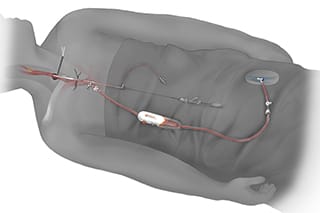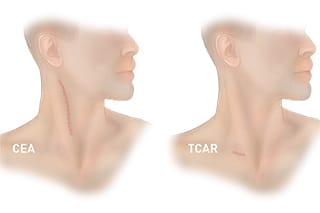TCAR
The Iowa Clinic is now offering a new procedure, called TransCarotid Artery Revascularization (TCAR), to treat patients with carotid artery disease who are at risk for open surgery. While any repair of the carotid artery carries some risk of causing a stroke because of the repair itself, TCAR was designed to help minimize that risk by keeping potential stroke causing fragments away from the brain.
Is TCAR right for you? Give us a call to find out.
CALL 515.875.9090
How does TCAR work?
Like the open surgery, carotid endarterectomy (CEA), this new procedure involves direct access to the carotid artery, but through a much smaller incision at the neckline just above the clavicle instead of a longer incision on the neck.
 During the TCAR procedure, a tube inserted into the carotid artery is connected to a system that temporarily directs blood flow away from the brain to protect against dangerous debris from reaching the brain during the procedure. Surgeons then filter the blood before returning it to a vein in the groin, and a stent is implanted directly into the carotid artery to stabilize the plaque and prevent future strokes. The entire procedure is performed in less than half the time of CEA — limiting the stress on the heart and significantly cutting the risk of the patient having a stroke or heart attack during the procedure.
During the TCAR procedure, a tube inserted into the carotid artery is connected to a system that temporarily directs blood flow away from the brain to protect against dangerous debris from reaching the brain during the procedure. Surgeons then filter the blood before returning it to a vein in the groin, and a stent is implanted directly into the carotid artery to stabilize the plaque and prevent future strokes. The entire procedure is performed in less than half the time of CEA — limiting the stress on the heart and significantly cutting the risk of the patient having a stroke or heart attack during the procedure.
How long is the procedure and recovery?
Patients who undergo the TCAR procedure recover quickly (typically spending just one night in the hospital) and almost always go home the next day to return to full and productive lives with less pain, smaller scars and a reduced risk of future strokes.
Is it safe?
TCAR has been studied extensively and is an FDA-cleared procedure. Over 3,000 procedures have been performed worldwide, and the clinical data have been excellent. Based on published clinical trials, the procedure offers several advantages:

- Better outcomes. TCAR results in a low peri-procedural stroke rate of 1.4% in high surgical risk patients1. This compares favorably to a 2.3% stroke rate of carotid endarterectomy and a 4.1% stroke rate of carotid artery stenting from a trans-femoral approach in standard risk patients2. TCAR’s low stroke rate is the lowest reported to date for any prospective, multi-center trial of carotid stenting.
- Less invasive. The TCAR approach has very low rates of cranial nerve injury and myocardial infarction due to a minimal incision near the clavicle and the transcarotid approach.
- Patient-friendly. Local anesthesia is favored, and hospital stays are typically overnight for observation. TCAR patients recover quickly and almost always go home the next day to return to full and productive lives with less pain and smaller scars.
Am I a candidate for TCAR?
Your physician may recommend the TCAR procedure if you’ve been diagnosed with carotid artery disease and are not a suitable candidate for CEA. This may depend on your age or other existing medical conditions.
For more information about TCAR, call us to schedule a consultation.
1 J Vasc Surgery 2015;62:1227-35; 2 N Engl J Med 2010;363:11-23